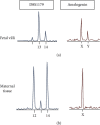Partial Molar Pregnancy Presenting as a Tubal Ectopic Pregnancy
- PMID: 35845975
- PMCID: PMC9277201
- DOI: 10.1155/2022/7414190
Partial Molar Pregnancy Presenting as a Tubal Ectopic Pregnancy
Abstract
Background: Tubal molar pregnancy is extremely rare, with no more than 200 cases reported in the literature. The incidence is approximated at 1.5 per 1,000,000 pregnancies.
Case: We report the case of a 22-year-old woman with an overall initial stable clinical presentation who was noted to have a ruptured ectopic pregnancy. She was surgically treated, and pathology revealed partial hydatidiform molar ectopic pregnancy. At the time of surgical intervention, the treating physicians had not considered molar ectopic pregnancy within the differential diagnosis, since this is a very rare presentation. Once the pathology was discovered, the patient was contacted to be scheduled for close follow-up and counseling to reduce progression to choriocarcinomas.
Conclusion: This case report highlights the importance of sending, reviewing, and following up on pathologic specimens for all patients undergoing surgical intervention for presumed ectopic pregnancy and ensuring that appropriate follow-up is in place for those patients.
Copyright © 2022 Mariam Ayyash et al.
Conflict of interest statement
The authors declare no conflict of interests regarding the publication of this paper.
Figures



Similar articles
-
Partial molar pregnancy as ruptured tubal ectopic.BMJ Case Rep. 2025 Feb 11;18(2):e263996. doi: 10.1136/bcr-2024-263996. BMJ Case Rep. 2025. PMID: 39933855
-
Ruptured tubal molar pregnancy.Niger J Clin Pract. 2012 Oct-Dec;15(4):491-3. doi: 10.4103/1119-3077.104537. Niger J Clin Pract. 2012. PMID: 23238205
-
Molar Pregnancy Presents as Tubal Ectopic Pregnancy: A Rare Case Report.J Clin Diagn Res. 2016 Jan;10(1):ED10-1. doi: 10.7860/JCDR/2016/14875.7089. Epub 2016 Jan 1. J Clin Diagn Res. 2016. PMID: 26894078 Free PMC article.
-
Misdiagnosis of appendicitis in tubally sterilized women.Aust N Z J Surg. 1993 Jan;63(1):68-70. doi: 10.1111/j.1445-2197.1993.tb00037.x. Aust N Z J Surg. 1993. PMID: 8466465 Review.
-
Bilateral tubal ectopic pregnancies: a report of two cases.Ann Afr Med. 2012 Apr-Jun;11(2):112-5. doi: 10.4103/1596-3519.93535. Ann Afr Med. 2012. PMID: 22406672 Review.
Cited by
-
Tubal ectopic molar pregnancy: A case report.Int J Reprod Biomed. 2024 Jul 8;22(5):405-410. doi: 10.18502/ijrm.v22i5.16441. eCollection 2024 May. Int J Reprod Biomed. 2024. PMID: 39091428 Free PMC article.
-
Partial Molar Ectopic Pregnancy: A diagnostic challenge.BMJ Case Rep. 2024 Apr 30;17(4):e255432. doi: 10.1136/bcr-2023-255432. BMJ Case Rep. 2024. PMID: 38688570
-
Invasive Hydatidiform Mole Mimicking Ectopic Pregnancy: A Case Report and Literature Analysis.Am J Case Rep. 2025 Jan 15;26:e946388. doi: 10.12659/AJCR.946388. Am J Case Rep. 2025. PMID: 39810412 Free PMC article. Review.
-
Isthmic tubal ectopic pregnancy from a partial molar pregnancy: A case report and literature review.Case Rep Womens Health. 2025 Jul 22;47:e00736. doi: 10.1016/j.crwh.2025.e00736. eCollection 2025 Oct. Case Rep Womens Health. 2025. PMID: 40746497 Free PMC article.
References
-
- Centers for Disease Control and Prevention. Ectopic pregnancy— United States, 1990-1992. MMWR. Morbidity and Mortality Weekly Report . 1995;44:46–48. - PubMed
-
- Soper J. T. H. C. Gestational trophoblastic neoplasms. In: Scott J. R., DiSaia P. J., Hammond C. B., Spellacy W. N., editors. Danforth’s Obstetrics and Gynecology . 6th ed. Philadelphia: Lippincott; 1990. pp. 1141–1155.
Publication types
LinkOut - more resources
Full Text Sources

